RESEARCHES
Robust Power System Security
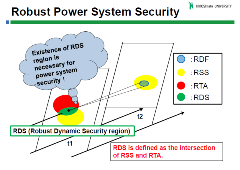
"A New Method of Evaluating Robust Power System Security against Uncertainties"
The rapid expansions of renewable energy (RE) generations lead to severe problems related to the reliability of network operation. Power system security is threatened by increased uncertainties of RE outputs and reduced controllable resources. Therefore, it is important to evaluate the robustness of the system controllability in order to preserve system security against uncertainties of RE outputs. We refer to the robustness of the system in this context as “Robust Power System Security.” This research proposes a new formulation for evaluating the robust security region in controllable parameter space wherethe conventional N-1 security criterion suffices in the presence of uncertainties. We specify confidence interval (CI) of uncertain parameters and obtain the worst case feasible region defined by a set of security constraints, which is very new approach in the treatment of uncertainties. We use the minimum set of static constraints in the load dispatching problemwith CI of RE prediction to evaluate the security region, which is referred to as Robust Static Security region (RSS) in this paper. The proposed method is useful to assess the degree of difficulty of system planning and operationfrom the viewpoint of the balance between controllable generator capacity and RE uncertainties.
Demand and Supply Management
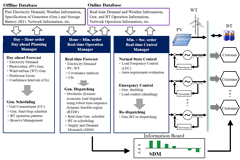
"Dynamic Economic Load Distpatch applied to a Energy Management System Controller"
At present, electric power systems face difficulties in system operations due to rapid increase in uncontrollable renewable energy sources (RES), such as photovoltaic power generations (PVs). Reduction of controllable resources also yields concerns about the supply reliability issues. This paper focuses on a new generation dispatching method for mitigating the irregularity associated with renewable power generation. A new algorithm is proposed for probabilistic economic load dispatch (PELD) as an efficient solution for a day-ahead and a real-time generation schedule (GS) that fully utilizes the limited resources of a power system under uncertainties. Real time PV forecasts with the co-relations of PV forecasting errors are effectively treated in the proposed method. Special feature of the proposed method different from the existing works lies in a frequent real-time update of GS by using a fast algorithm to maximize robustness against uncertainties.
Stability Analysis

"Robust method for detection of CUEP in Power Systems"
Transient stability analysis plays an important role concerned with the ability of power systems to reach steady state following large disturbances. Today’s power systems are operated in significantly stressed state close to their limits. Fast determination of the system response is a crucial issue which raises the need for online stability assessment. Direct methods appear to be key approach to this problem of the power system transient stability analysis. A new robust method for detecting Controlling Unstable Equilibrium Point (CUEP) is proposed in this research. The solution is obtained on basis of a minimization problem. The critical trajectory method (CTrj), another our approach, is applied to the Boundary of stability region based Controlling UEP (BCU) method. The method is combined with new criterion characterized by the potential energy boundary surface (PEBS) property. Starting from an exit point the method computes simultaneously multiple points of a trajectory that reaches CUEP. The effectiveness of the method is demonstrated through test power system models.
Distribution System
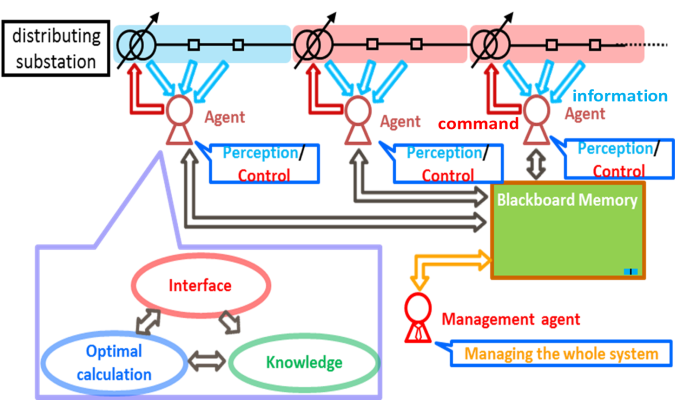
"An Optimal Autonomous Decentralized Control Method for Voltage Control Devices by Using a Multi-Agent System"
Impact of increasing penetration of photovoltaic (PV) generation is expected in Japan in the near future; thus a new voltage control scheme is required in order to improve the operation of distribution networks. We propose a new voltage control scheme for distribution networks based on a multi-agent system. The large voltage fluctuations caused by PV generations are effectively regulated by adjusting the conventional types of tap-changing controllers. We achieved an optimal control performance by developing a new optimal control law applicable to decentralized autonomous control. The autonomy is accomplished by using a multi-agent system. The proposed method is applicable to general distribution network and highly efficient for popular radial networks under certain approximations. The effectiveness of the proposed scheme is demonstrated through numerical simulations of radial 6.6-kV test system with successful results.
Voltage and Reactive Power
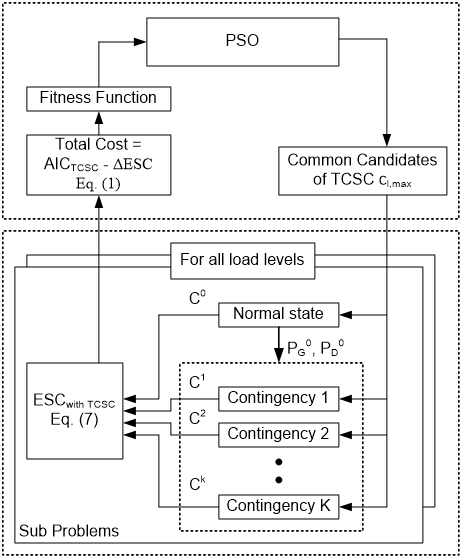
"Expected Security Cost-Based FACTS Devices Allocation Using Hybrid PSO"
This research focus on FACTS devices allocation for market based power systems. The purpose of the FACTS installation is to provide benefit for all entities. Therefore, we use a concept of minimizing Expected Security Cost (ESC), implying to maximize social welfare, to minimize operating reserve, and to minimize load interruption in annual basis. The FACTS devices investment cost is also taken into account. The ESC considers operating cost under normal state and contingencies along with their associated probabilities to occur. Annual basis bid data is used to compute ESC as well as the cost data for load interruption and reserve procurement. This research also considers control actions among multiple FACTS devices to achieve minimum ESC. To solve the overall problem, Particle Swarm optimization (PSO) is utilized to obtain optimal FACTS devices allocation as main problem while Sequential Quadratic Programming (SQP) is used to solve optimal power flow as sub optimization problem.
Circuit Design for FACTS, Inverters, etc.
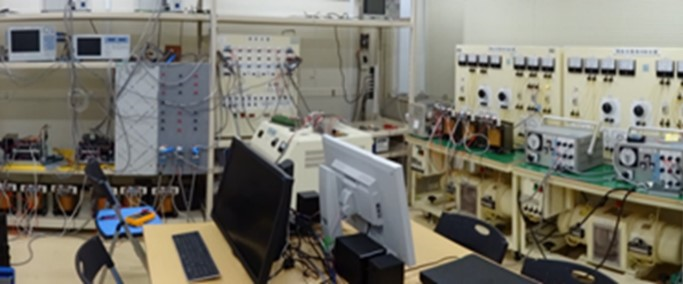
"A Study on Voltage Source Converter with Synchronizing Power for Power System Stabilization"
In this research, we focus on a new inverter model for improving the power system transient stability. Generally, Renewable energy sources (RESs) connect to the conventional power systems by using power electronics device such as inverters or converters. However, in the present circumstance, the inverters cannot continue to operate as normal power supply mode when sudden changes of power consumption or instantaneous voltage drops occur by electrical transients in power systems. With rapid increasing the installation capacity of RESs, a number of power electronics devices will probably be necessary. In order to transmit the electric power stably and efficiently, we need to develop the inverter for high performance and large capacity. We propose the novel inverter model in order to contribute the power system stability by imitating the synchronizing power of the synchronous generator. We confirm that the inverter continue to operate stably against system disturbance with PSIM and simple verification test.
Electric Power Energy and System Laboratory,
Graduate School of Engineering,
Hiroshima University
739-8527
Kagamiyama 1-4-1
Higashihiroshima
JAPAN
Contact.
yusasaki [at] hiroshima-u.ac.jp
*Please change [at] to @.